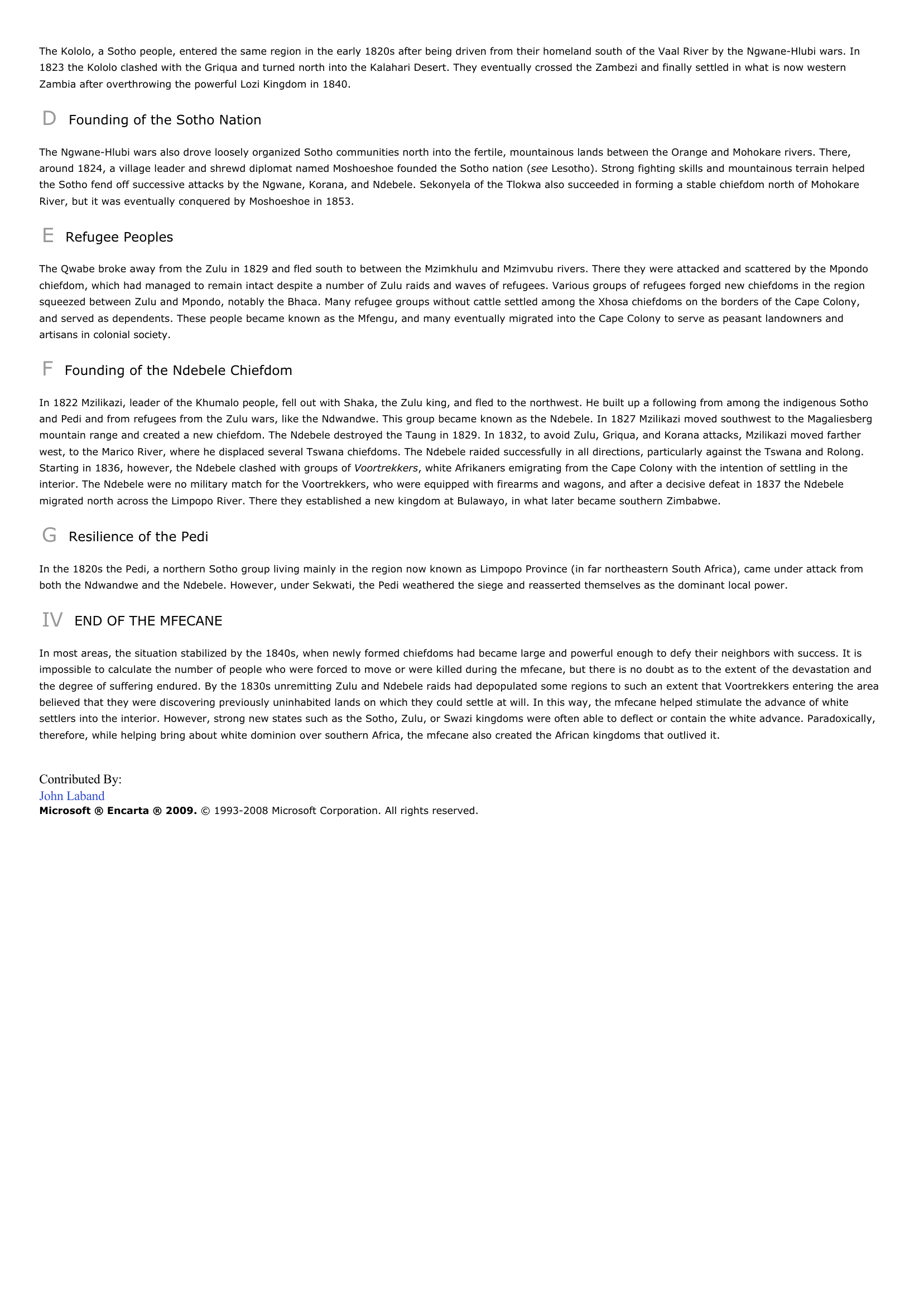Mfecane.
Publié le 20/08/2013

Extrait du document
«
The Kololo, a Sotho people, entered the same region in the early 1820s after being driven from their homeland south of the Vaal River by the Ngwane-Hlubi wars.
In1823 the Kololo clashed with the Griqua and turned north into the Kalahari Desert.
They eventually crossed the Zambezi and finally settled in what is now westernZambia after overthrowing the powerful Lozi Kingdom in 1840.
D Founding of the Sotho Nation
The Ngwane-Hlubi wars also drove loosely organized Sotho communities north into the fertile, mountainous lands between the Orange and Mohokare rivers.
There,around 1824, a village leader and shrewd diplomat named Moshoeshoe founded the Sotho nation ( see Lesotho).
Strong fighting skills and mountainous terrain helped the Sotho fend off successive attacks by the Ngwane, Korana, and Ndebele.
Sekonyela of the Tlokwa also succeeded in forming a stable chiefdom north of MohokareRiver, but it was eventually conquered by Moshoeshoe in 1853.
E Refugee Peoples
The Qwabe broke away from the Zulu in 1829 and fled south to between the Mzimkhulu and Mzimvubu rivers.
There they were attacked and scattered by the Mpondochiefdom, which had managed to remain intact despite a number of Zulu raids and waves of refugees.
Various groups of refugees forged new chiefdoms in the regionsqueezed between Zulu and Mpondo, notably the Bhaca.
Many refugee groups without cattle settled among the Xhosa chiefdoms on the borders of the Cape Colony,and served as dependents.
These people became known as the Mfengu, and many eventually migrated into the Cape Colony to serve as peasant landowners andartisans in colonial society.
F Founding of the Ndebele Chiefdom
In 1822 Mzilikazi, leader of the Khumalo people, fell out with Shaka, the Zulu king, and fled to the northwest.
He built up a following from among the indigenous Sothoand Pedi and from refugees from the Zulu wars, like the Ndwandwe.
This group became known as the Ndebele.
In 1827 Mzilikazi moved southwest to the Magaliesbergmountain range and created a new chiefdom.
The Ndebele destroyed the Taung in 1829.
In 1832, to avoid Zulu, Griqua, and Korana attacks, Mzilikazi moved fartherwest, to the Marico River, where he displaced several Tswana chiefdoms.
The Ndebele raided successfully in all directions, particularly against the Tswana and Rolong.Starting in 1836, however, the Ndebele clashed with groups of Voortrekkers , white Afrikaners emigrating from the Cape Colony with the intention of settling in the interior.
The Ndebele were no military match for the Voortrekkers, who were equipped with firearms and wagons, and after a decisive defeat in 1837 the Ndebelemigrated north across the Limpopo River.
There they established a new kingdom at Bulawayo, in what later became southern Zimbabwe.
G Resilience of the Pedi
In the 1820s the Pedi, a northern Sotho group living mainly in the region now known as Limpopo Province (in far northeastern South Africa), came under attack fromboth the Ndwandwe and the Ndebele.
However, under Sekwati, the Pedi weathered the siege and reasserted themselves as the dominant local power.
IV END OF THE MFECANE
In most areas, the situation stabilized by the 1840s, when newly formed chiefdoms had became large and powerful enough to defy their neighbors with success.
It isimpossible to calculate the number of people who were forced to move or were killed during the mfecane, but there is no doubt as to the extent of the devastation andthe degree of suffering endured.
By the 1830s unremitting Zulu and Ndebele raids had depopulated some regions to such an extent that Voortrekkers entering the areabelieved that they were discovering previously uninhabited lands on which they could settle at will.
In this way, the mfecane helped stimulate the advance of whitesettlers into the interior.
However, strong new states such as the Sotho, Zulu, or Swazi kingdoms were often able to deflect or contain the white advance.
Paradoxically,therefore, while helping bring about white dominion over southern Africa, the mfecane also created the African kingdoms that outlived it.
Contributed By:John LabandMicrosoft ® Encarta ® 2009. © 1993-2008 Microsoft Corporation.
All rights reserved..
»
↓↓↓ APERÇU DU DOCUMENT ↓↓↓




















